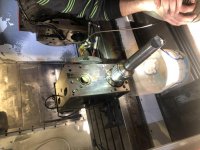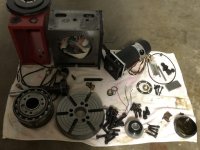countryguy
Hot Rolled
- Joined
- Jul 29, 2014
- Location
- Mich, USA
Hi Everyone,
latest issue; Haas VF/4 1998 w/ the RED TRT210.
(Which is a conjoined 310 and 210 this kid is telling me.)
The B platter. smaller has 1.5 thou Haas air/how-to doc backlash test and .003 if you indicate and just turn the wheel.
I have the original paperwork with the unit from new. listed as .0002 when new on the yellow Haas sheet from 1997?
Soooooo When we dumped the fluid on B- It looked like dirty motor oil. I assuemd someone filled w/ the wrong fluid? Saw a Haas doc today that said something about a bad seal and fast wear and backlash cause.
Anyway- It needs to be repaired. Do you find sending it into CA is the way to go, or try to get the parts and fix yourselves?
Or does anyone know if there really is anything to 'adjust' inside. I see a bit of both on the threads and searches. Most say no... but there are a few that note an adjustment screw? (Son is telling me).
TIA!
latest issue; Haas VF/4 1998 w/ the RED TRT210.
(Which is a conjoined 310 and 210 this kid is telling me.)
The B platter. smaller has 1.5 thou Haas air/how-to doc backlash test and .003 if you indicate and just turn the wheel.
I have the original paperwork with the unit from new. listed as .0002 when new on the yellow Haas sheet from 1997?
Soooooo When we dumped the fluid on B- It looked like dirty motor oil. I assuemd someone filled w/ the wrong fluid? Saw a Haas doc today that said something about a bad seal and fast wear and backlash cause.
Anyway- It needs to be repaired. Do you find sending it into CA is the way to go, or try to get the parts and fix yourselves?
Or does anyone know if there really is anything to 'adjust' inside. I see a bit of both on the threads and searches. Most say no... but there are a few that note an adjustment screw? (Son is telling me).
TIA!










